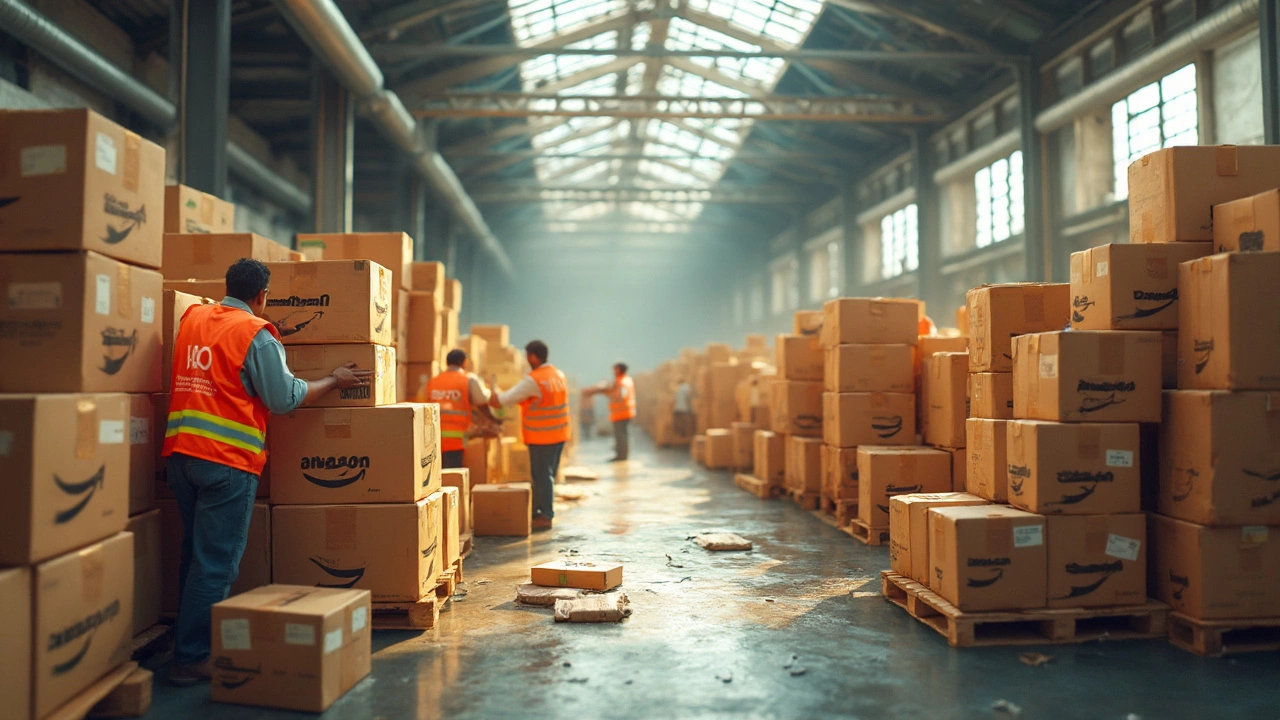Ever scrolled through social media and seen those wild videos of people unboxing giant random boxes labeled “Amazon pallets”? It almost looks too good to be true—like striking gold for only a couple hundred bucks. So, is this real or just internet smoke and mirrors?
Here’s the deal: Amazon pallets are a real thing, but they aren’t some kind of secret Amazon deal. They’re just big lots of returned, overstocked, or unsold products bundled up and sold to whoever wants them—mostly through liquidation companies, not Amazon itself. People buy these pallets hoping to flip the items for profit, stock a shop, or just hunt for cool finds.
If you’re interested in getting one delivered, don’t expect it to show up at your front porch like a regular package. Most pallet deliveries need a big truck (think semi or box truck) and curbside drop-off, not door-to-door hauling. If you live in a fourth-floor apartment with narrow stairs…well, let’s just say it gets tricky.
- Amazon Pallets: What Are They Really?
- How Amazon Pallet Delivery Works
- The Truth Behind 'Mystery' Pallets
- What’s Actually Inside an Amazon Pallet?
- Risks and Pitfalls Most People Miss
- Tips for Amazon Pallet Reselling Success
Amazon Pallets: What Are They Really?
When people talk about "Amazon pallets," they’re usually thinking about a giant wooden platform stacked with random stuff, shrink-wrapped, and ready to ship. These aren’t pallets sent straight from Amazon warehouses to your door. Instead, they’re filled with Amazon pallets—products that come from customer returns, warehouse overstock, clearance items, or stuff Amazon just wants to get off the books fast.
Here’s how it usually breaks down:
- Returns: Everything from open-box electronics to gently used kitchen blenders. Some work, some don’t.
- Overstock: Excess products Amazon never sold, maybe from last season or just too many ordered from suppliers.
- Damaged packaging: The product inside is fine, but the box took a hit in shipping or during shelf stocking. Retailers can’t sell them as “new.”
- Discontinued goods: Items Amazon archived and won’t restock, so they need to move whatever’s left.
These pallets usually end up at large liquidation companies. They buy bulk loads from Amazon, group them onto new pallets, and then resell to anyone willing to take a gamble. You don’t need to be a business owner—you can often buy a single pallet if you have the cash and a way to get it home.
What does it all look like in practice? Here’s a quick snapshot of a typical Amazon liquidation pallet breakdown:
| Type | % of Typical Pallet | Chance It's Working |
|---|---|---|
| Electronics | 20% | Around 60% |
| Household goods | 30% | About 85% |
| Toys & games | 15% | Roughly 90% |
| Clothing | 25% | Nearly 100% |
| Other | 10% | Depends |
These numbers come from bulk buyers’ reports and might shift based on where you live or which liquidation company you buy from. So, the next time you see a listing for an Amazon pallet, you’re not getting a box straight from Amazon. You're buying a mixed bag from a middleman who probably didn’t open a single box. It’s as real as it gets—if you know what you’re actually getting into.
How Amazon Pallet Delivery Works
Getting your hands on one of these so-called Amazon pallets starts with finding the right place to buy. You won’t find them up for grabs on Amazon’s main site. Instead, they’re usually listed on liquidation marketplaces like Liquidation.com, B-Stock, or Direct Liquidation. Some folks even check out local auctions or pallet wholesalers in their area.
Once you pick your pallet (usually sight unseen except for a general manifest), you’ll pay up front. Most sites show basic details: the type of goods, rough condition (new, returned, overstock), and where it’s stored. Big sites let you filter by location so you can avoid huge shipping costs.
Delivery’s where things can surprise you. Pallets aren’t little boxes—they’re big wooden platforms stacked with boxes or loose goods, often shrink-wrapped. Expect dimensions around 48x40 inches and heights up to six feet, sometimes weighing over 500 pounds. That’s why most sellers use freight companies.
Here’s how pallet delivery normally shakes out:
- Your shipping cost is calculated based on pallet size, weight, delivery distance, and whether you have a loading dock or need a liftgate truck (helpful if you’re a regular address—no forklift at home).
- Freight deliveries are typically curbside. Unless you specify, drivers won’t help lug pallets inside.
- Timeframes can vary. After you pay, it often takes 3–7 business days for pallets to be processed, loaded, and shipped out. Actual delivery depends on your location but usually lands somewhere between 4 and 12 days total from purchase to arrival.
Need an idea of costs? This simple table shows what you might shell out for pallet delivery, based on real 2024 averages:
| Delivery Zone | Average Cost per Pallet | Estimated Time |
|---|---|---|
| Same State | $125 – $250 | 3–5 days |
| Nearby States | $200 – $350 | 5–8 days |
| Cross-country | $275 – $500 | 7–12 days |
Quick tip: Make sure you’re able to accept delivery on a certain day, because missed freight deliveries can cost you extra or delay the whole thing. And ask sellers if there’s a loading dock fee or charges for hard-to-reach addresses. That stuff adds up fast.
The Truth Behind 'Mystery' Pallets
Here’s where things get interesting—and a bit shady if you don’t know what you’re doing. The "mystery" part comes from not really knowing what’s inside the pallet. Sure, you’re promised an "Amazon pallet," but what does that even mean in the real world? You’re not buying straight from Amazon. Instead, third-party liquidators scoop up huge loads of returns, shelf-pulls, and unsold stuff from Amazon warehouses. They package them onto pallets and sell them off—sometimes as neat lists, sometimes with almost zero description. That’s why some pallets look promising while others are total shots in the dark.
Don’t expect to get the latest tech or a box of iPhones. Most Amazon pallets are a mix of electronics, clothes, toys, kitchen items—whatever Amazon had too much of or got sent back. Sometimes liquidators will give you a general idea (like "electronics" or "home goods"), but the details? Not so much. The element of surprise is real.
Scams do exist. Watch out for sketchy websites or sellers on social media promising insane deals. Genuine liquidators will at least show you real photos or manifests (basically, a basic list of what’s inside). If you get stuck with a mystery pallet from a random Facebook seller, there’s a decent chance you’ll get boxes of broken or useless junk—and no returns.
Quick checklist for legit mystery pallets:
- Buy only from trusted liquidation companies with reviews and actual contact info.
- Check for a manifest. Even a rough item list is better than nothing.
- Avoid sellers asking for cash payments or using sketchy payment apps with no buyer protection.
- Be realistic. Mystery means you might hit the jackpot, or you might end up with a pallet of shower curtains and Christmas socks.
Bottom line: the mystery is half the fun, but don’t let it blind you to the risks. Do a little homework before buying—your wallet will thank you.

What’s Actually Inside an Amazon Pallet?
What you find in an Amazon pallet is pretty much a mixed bag—literally. These pallets are mostly made up of returned items, overstock, shelf pulls, or even stuff that just didn’t sell fast enough on Amazon. The contents aren’t handpicked by anyone; they’re just bundled together based on category or warehouse location and shrink-wrapped for delivery.
Here’s the breakdown of the types of stuff you might get:
- Electronics: Headphones, smartwatches, speakers—but sometimes missing original packaging or small accessories.
- Clothing and Shoes: Racks of fashion at various sizes and styles, with some being perfectly new and others clearly tried on.
- Home Goods: Think small kitchen appliances, bedding, or random décor.
- Toys and Games: Everything from board games to action figures, sometimes with boxes beat up in shipping.
- Miscellaneous: Sometimes you’ll see oddball items, like office supplies, beauty products, or even pet accessories.
It’s kind of like a garage sale, warehouse edition. You don’t get to choose specific brands or types—unless you’re buying from a seller who accurately manifests (lists) what’s in the pallet, and even then, it’s not 100% reliable.
A question everyone asks: How much of this stuff actually works or is in good shape? Here’s some rough data pulled from a large 2023 liquidation company:
| Condition | Approximate Percentage |
|---|---|
| New/Sealed | 20% |
| Like New/Open Box | 30% |
| Used/Functional | 35% |
| Damaged/Parts Only | 15% |
This means you’ve got a shot at finding some treasures, but there’s a fair chunk of duds too. Don’t expect everything to be salable or ready for a gift. It’s basically the reality of the Amazon pallets game—some wins, some losses.
Risks and Pitfalls Most People Miss
Buying an Amazon pallet sounds like a bargain, but there are plenty of ways it can go sideways if you’re not careful. The biggest shock? You almost never get a complete list of what’s in the pallet. That’s the gamble—sometimes you score, sometimes you end up with broken electronics, expired products, or stuff you can’t even resell locally.
Returns are the name of the game here. Most Amazon pallets come packed with items customers sent back. These returns might be brand new, but a lot of times they’re scratched, missing pieces, or flat-out busted. Occasionally, you’ll find clothes with missing tags, kitchen gadgets without instructions, or toys that just don’t work. Testing and sorting every item takes time—don’t skip this part unless you want headaches later.
Fake or knockoff products can slip through. Amazon cracks down on counterfeits in regular sales, but liquidation pallets are way less strict. You could end up with off-brand electronics, “designer” bags that aren’t, or beauty products past their best-before dates. Selling this stuff can be illegal and could wreck your reputation if it lands on your online shop.
There’s also the delivery curveball. Most of these pallets are sent freight, so if you don’t have a place to put a 4-foot by 4-foot wooden pallet—or a friend with a truck—you might face extra delivery fees or the pallet getting sent back. And don’t forget about surprise shipping costs, which sometimes add hundreds to your total bill. Always double-check if “free delivery” actually covers your address.
- Check for reviews on the specific liquidation supplier, not just general YouTube videos—scams exist.
- Set a hard budget and stick to it. Add in taxes, shipping, and possible disposal costs for totally unsellable stuff.
- Inspect each item as soon as it arrives, take photos for records, and deal with returns or disputes right away.
Bottom line: Buying these pallets can be fun and profitable, but only if you stay sharp, realistic, and do a little homework. Don’t get caught up in the hype and forget that, like any gamble, the house usually wins.
Tips for Amazon Pallet Reselling Success
Not everyone wins big with Amazon pallets. If you want to avoid turning your garage into a graveyard of unsellable stuff, you need a plan. Here’s how people actually make money and stay out of trouble with pallet reselling.
First, know your costs. It’s not just the pallet price—add shipping (which can be a couple hundred bucks by itself), plus sales fees if you’re using eBay, Facebook Marketplace, or a local auction site. According to Direct Liquidation, “Shipping can make or break your profit margin, especially if you’re buying from out of state.”
If you’re reselling, you have to know your market and have a rough idea of what you’ll do with excess stock. — Direct Liquidation
Don’t wing it with mystery pallets. Lots can be a complete gamble, but some sellers give manifests, which list what’s inside (or at least claim to). Manifests aren’t foolproof, but they’re way better than shopping blind.
- Always check for a manifest before you buy. The more itemized, the better.
- Start small. Order one or two pallets, not a whole truckload.
- Look for focused categories (like electronics, toys, or home goods) instead of mixes of random stuff.
Another solid move: research your local resale market. What sells fast in one area might sit for ages in another. For example, some cities are flooded with returned baby gear, so prices tank. It’s worth browsing your local resale groups before you even order.
| Pallet Type | Average Cost | Estimated Resale Value |
|---|---|---|
| Electronics | $600-$1,200 | $1,000-$2,000 |
| Home Goods | $400-$900 | $800-$1,500 |
| Mixed Goods | $300-$800 | $500-$1,200 |
After buying, test every product you can. Stuff that’s missing parts or broken needs to be disclosed—or you’ll get hit with returns and angry buyers. A working power drill is worth a lot more than one that doesn’t fire up. Take clear photos and be totally honest in your listings.
Finally, don’t quit your day job on your first win. This is a grind—it takes patience, storage space, and solid hustle. But with some research, the right buying choices, and a few local connections, you can actually pull a profit.





